SEARCH


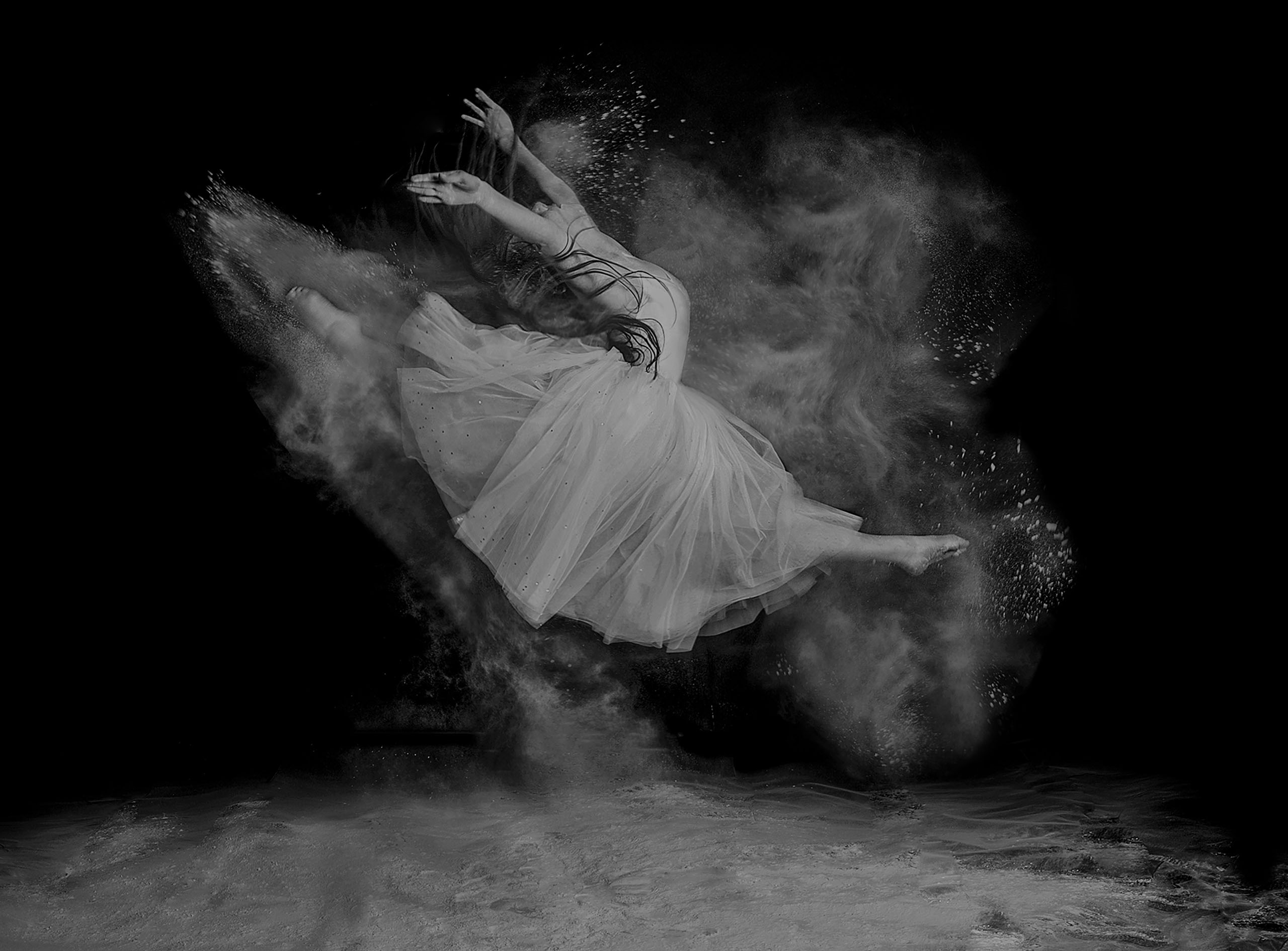
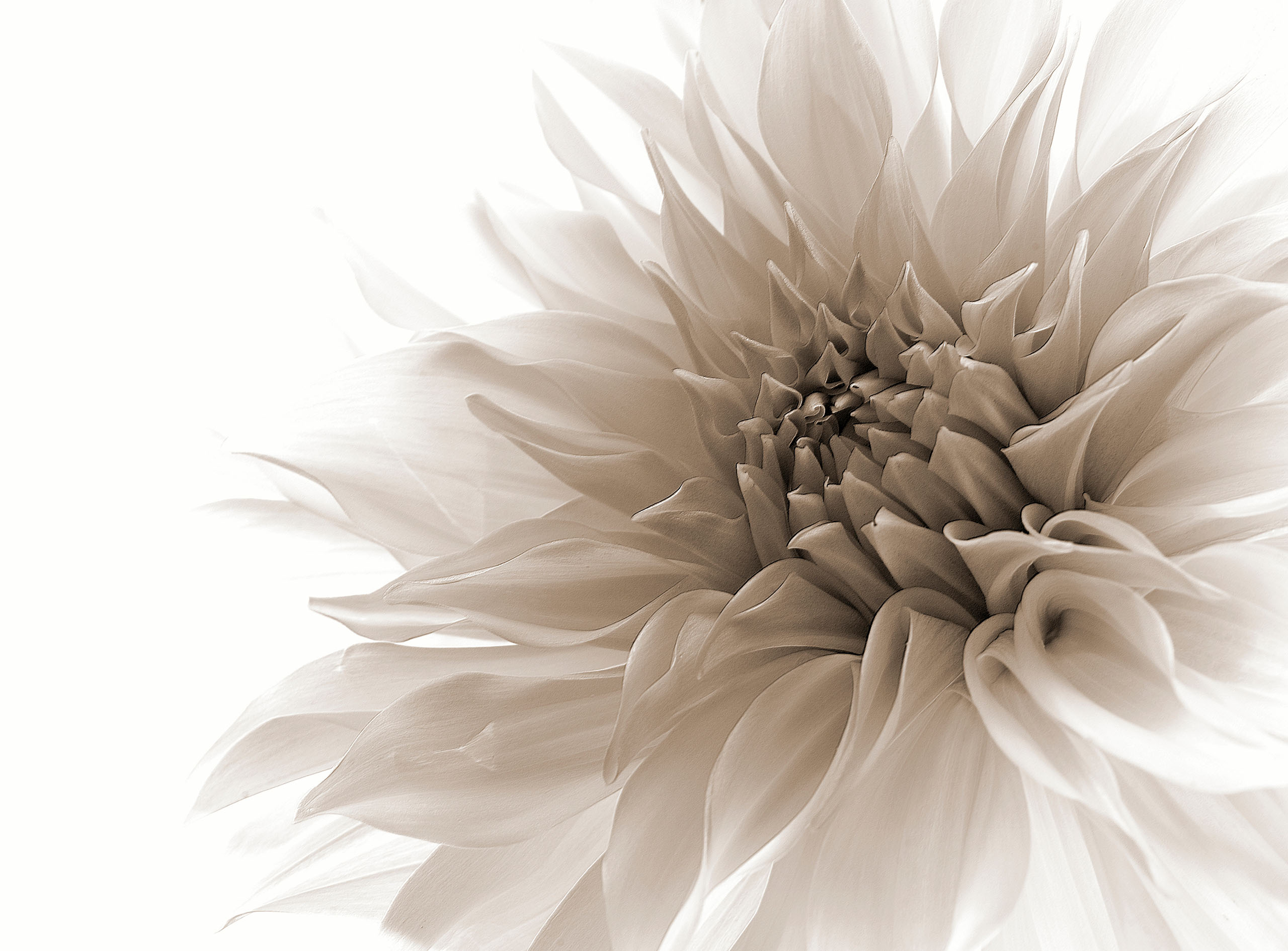
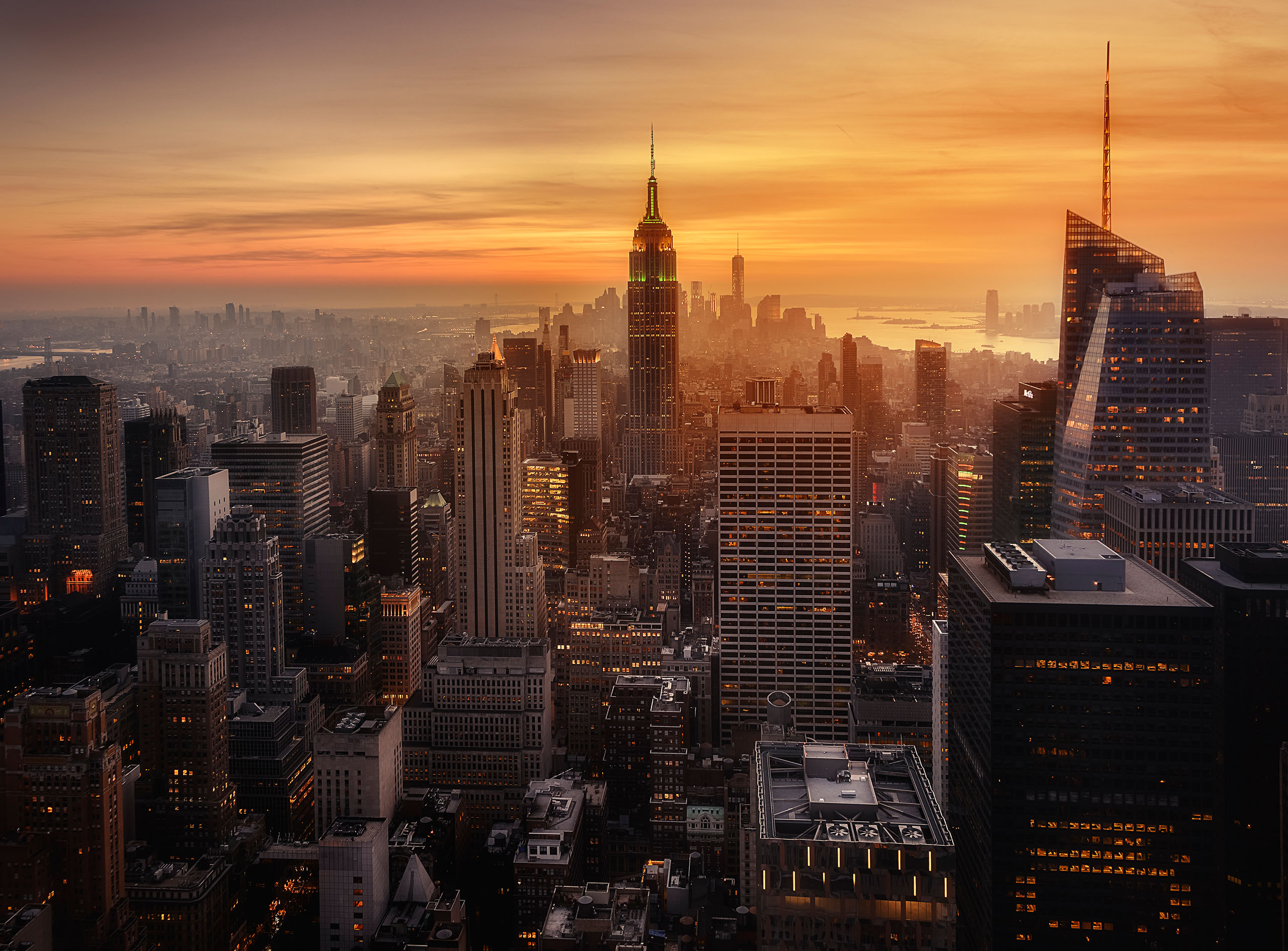
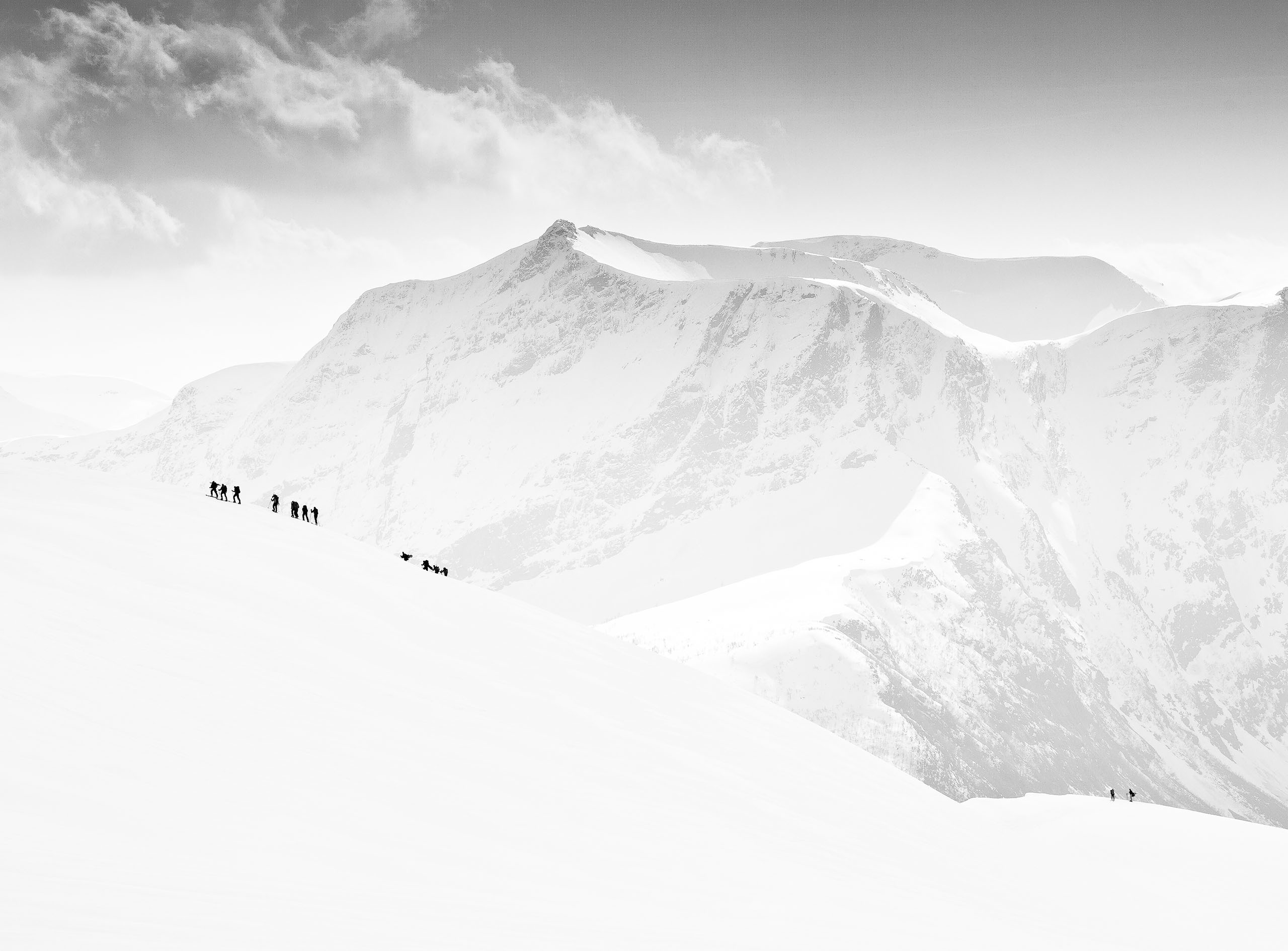
|
|
|
|


by Editor Miro Susta (mirosu)
Edited and published by Yvette Depaepe, the 15th of December 2025
This article is part four of a five parts series on Olympic and non-Olympic sports.
The previous articles can be found under the following links:
Summer Olympic Sports-Part 1
Summer Olympic Sports-Part 2
Non-Olympic Sports Part 1 - Summer Outdoor Sports
'Best Team Member' by Molly Fu APA
In previous articles, I haven't explained why I write about sports. The simple answer is that I have been closely involved with both sports and photography throughout my life. In my early years, I was a high-performance athlete who competed in 800- and 1,500-metre races. I then became an ice hockey player in a Swiss club, followed by a passionate alpine and cross-country skier and finally an active golfer. I combined my two passions, working mainly as a photographer at professional golf competitions for Swiss and German golf magazines.
In this article, I am focusing on non-Olympic winter and non-Olympic indoor sports. All photos originate from 1x Photo Gallery.
WINTER SPORTS
Long distance extreme ski races…
... they are very hard and incredibly challenging, but for many, they are also the most spectacular cross-country skiing races.
At 220 kilometres, Nordenskiöldsloppet is the world's longest cross-country skiing race. It takes you through the forests and frozen lakes of Swedish Lapland. The course, which is located north of the Arctic Circle, involves ascending and descending a total of about 1,500 metres.
The Arctic Circle Race in Greenland is also designed for hardcore cross-country skiers. With temperatures sometimes dropping to minus 20 degrees Celsius, icy winds, challenging climbs and rapid descents, the technical demands on participants are high. The race covers a total distance of 160 kilometres, with two overnight stays in unheated bivouac tents.
‘Bivouac at Bouquetins’ by Karol Nienartowicz
Extreme downhill skiing…
… refers to long, challenging courses such as the Inferno, the world's oldest and longest amateur downhill ski race, which takes place every January in the Swiss winter resort of Mürren. The course is 14.9 km long and involves a 1,990-metre vertical drop.
‘Ski is life’ by Sandi Bertoncelj
‘Silent Moments before Descent’ by Sandi Bertoncelj
Freeride skiing, hiking and racing…
… combines elements of traditional racing with freeride skiing. Athletes ski on natural, ungroomed terrain and are judged on line choice, fluidity, control, jumps and time. While the hardest ski freeride competition is subjective, the Freeride World Tour (FWT) is widely regarded as the world's premier event, with its finals held at the legendary Xtreme Verbier in Switzerland.
Verbier’s Bec des Rosses is synonymous with extreme freeriding. At 3,223 metres high with a 600-metre vertical drop and 43-degree slopes, it is the steepest and most complex terrain on the FWT circuit. Riders must navigate a maze of narrow couloirs, exposed ridges and huge cliffs, selecting lines that blend technical precision with progressive freestyle moves.
‘Higher’ by Tristan Shu
The Red Bull Oslavia Hike & Ride is an annual freeride skiing competition in Romania that combines hiking up a mountain and skiing down it.
‘Red Bull OSlea Hiride 2019’ by ATTILA SZABO
Speed skiing...
… considered a simple yet dangerous sport, it involves individual racers in aerodynamic suits speeding down steep slopes and pushing the speedometer to its limits. In 2016, world records were set for both men and women, with speeds exceeding 240 km/h (the current men's world record stands at 255.5 km/h). Speed skiing continues to attract passionate and dedicated adventurers to the annual World Cup.
However, the speed skiing competition was tragically overshadowed by the fatal training accident of Nicolas Bochatay at the 1992 Albertville Olympics, and the IOC has not considered it since.
‘One of those days’ by Jakob Sanne
Ski mountaineering…
… competitive ski mountaineering (Skimo) originated in Switzerland, evolving from the military team competition of the Patrouille des Glaciers ski mountaineering race. This race, which takes place from Zermatt to Verbier, was first held in 1943 and has grown in popularity over time. Military patrols competed against each other to complete a specified mountain route on skis as quickly as possible. In fact, the patrol was even part of the 1924 Olympic Games in Chamonix.
This sport's roots go back to the early days of alpine skiing, when it was common practice to make the ascent under your own steam in the absence of ski lifts or cable cars.
‘Step by step’ by Marcel Rebro
‘Windy mountain’ by Sandi Bertoncelj
Winter Horse Racing…
…which takes place in the Chinese town of Kanas during the traditional yearly Ice and Snow Festival. The races are sometimes held in extremely cold temperatures and feature performances and events such as chases, as well as traditional competitions.
‘Winter Horse Race’ by BJ Yang
Sled dog racing...
... is a winter sport that is particularly popular in the Arctic regions of the United States (Alaska), Canada, Russia, Greenland, Norway, Finland and Sweden. It involves teams of sled dogs pulling a sled with the driver, or 'musher', standing on the runners in a timed competition.
Sprint races cover relatively short distances of generally up to 30 miles per day, mid-distance races cover 30 to 300 miles in total, and long-distance races cover between 300 and 1,000 miles.
‘A snowy day’ by Larry Deng APA
‘Running as One’ by Steven Zhou
Reindeer races…
… are colourful and speedy competitions that form an essential part of northern reindeer culture. They have been held in Finland's Lapland since 1932 and remain a popular winter sport there. Today, reindeer races are also organised and regulated in Norway, the USA (Alaska) and Russia.
‘Faster than wind’ by Andrey Snegirev
The White Turf…
… takes place in St. Moritz, Switzerland, and is one of the most famous horse races in the world. For 117 years, the frozen Lake St. Moritz has served as a racecourse and the social hub of the Engadin Valley, one of the highest inhabited valleys in Europe at over 2,000 metres above sea level. The White Turf is a unique spectacle where horses and jockeys compete not on sand or grass as usual, but on the frozen surface of Lake St. Moritz. For over a century, this traditional horse race has offered a unique experience in the snow over three weekends in February each year.
‘White Turf’ by Ludwig Loch
Winter car rallies…
… are competitions in which drivers race on modified tracks or off-road using special techniques adapted for slippery surfaces. These events take place during the winter months and are primarily designed for 4x4 vehicles. Competitors must master challenging conditions such as driving on snow and ice, using techniques such as smooth braking to grip and control the vehicle. The most famous winter rally is the Rallye Monte Carlo, a modern version of the original 1,070 km Paris-Monte Carlo rally launched in 1911. Held every January, it consists of 14 to 22 stages (300 to 600 km) on challenging winter roads in the French and Italian Alps.
‘Lancia Fulvia’ by ATTILA SZABO
Long-distance ice skating...
It is particularly popular in the Netherlands. The Elfstedentocht race is well known: a historic long-distance speed skating event spanning almost 200 km. Taking place in the northern province of Friesland, it passes through all eleven of the province's historic cities. The race takes place once a year at most, but only if the natural ice along the entire route is at least 15 centimetres thick.
‘Dance of the long knives’ by Dusan Ignac
Winter cross-country cycling races…
… require adapted riding techniques and route planning. This includes reducing speed, braking and steering carefully when cornering, and choosing paths without large amounts of snow or ice. There are two types of winter cross-country cycling race: cyclocross, which takes place during the cold season and involves riding modified road bikes over obstacles such as mud and sand; and alternative winter cycling races. Alternatively, winter cycling races may be held.
‘Take a Ride on the Sunny side’ by Sandi Bertoncelj
Winter sailing regattas...
… examples include the Frostbite Winter Race Series in Jersey and the J/70 Winter Series in Turkey, as well as various other regattas held in locations such as the United States, Italy and Spain. Iceboat racing, a unique form of winter sailing, takes place on frozen lakes when conditions are suitable. The Royal Channel Islands Yacht Club's winter sailing race series in St. Aubin's Bay, Jersey, is also very popular, combining Sunday morning racing with social gatherings at the club.
‘Greenland night’ by Marc Pelissier
SELECTED NON-OLYMPIC INDOOR SPORTS
Bowling...
… although it is not an Olympic sport, bowling is one of the most popular sports in the Special Olympics.
‘Bowling girl’ by Igor Makarov
Snooker and billiards…
… they differ in terms of equipment and rules. Snooker is played on a larger table with smaller balls and narrower pockets, making the game more technically demanding. Additionally, the order in which the balls must be pocketed and the scoring system are fixed in snooker, unlike in other billiards variants, such as 8-ball, where the entire group of balls often must be pocketed.
‘Billiards’ by Juan Luis Duran
‘And all of a Sudden Everything was Calm’ by Alex OBrien
Chess…
… the International Olympic Committee has labelled it a sport and recognises FIDE as an official federation. However, chess is not approved for the Olympics. One reason for this is that chess does not involve physical exertion or athleticism in the same way as traditional Olympic sports.
‘Chess school in Cuba’ by Santos Moreno
‘Chess game’ by Fang Tong
Dance sport...
... is not only an artistic activity, but also encompasses athleticism and artistry. It combines the rigour of sport with the expressiveness of art.
Dance sports include Latin American and standard dances, as well as rock 'n' roll, boogie-woogie, jive and West Coast swing, and modern line dancing. At dance tournaments, couples compete against each other.
‘Carmen’ by Eleonora Abbagnato by Flavio Bertazzi
Darts...
… the first hurdle would be that it doesn't have a governing body that's recognized by the Olympics.
‘Training with heartbeat’ by Christine von Diepenbroek
Netball…
... is a team sport played on a rectangular court with raised goal rings at each end. Games are played on a rectangular court with raised goal rings at either end. The aim is to score goals from within a defined area. It is similar to basketball, but allows less physical contact between players, such as blocking and screening. Netball has stricter rules regarding physical contact; defensive players must keep a certain distance from the player with the ball.
‘Line’ by Ovi D. Pop
Karate…
… is a martial art involving striking, blocking and kicking. Although it was included in the Tokyo 2020 Olympics, it is not part of the permanent Olympic programme.
'Wake Up!!!' by Marcel Rebro
Mixed martial arts (MMA) …
... is a full-contact combat sport in which a wide variety of techniques and skills from other combat sports can be used in competition. However, the sport's violent nature and lack of a standardised scoring system have so far prevented its inclusion in the Olympics.
‘Fighters’ by Henry Zhao
Some other non-Olympic winter and indoor sports exist, such as bandy, ice hockey, synchronised figure skating, natural track luge, ski orienteering, snow volleyball, 3x3 ice hockey, ice climbing, rope climbing, floorball and indoor football. Unfortunately, there are no corresponding photos in the 1x photo gallery.
‘Skeleton face’ by Markus Hülsbusch
The final article in this series will focus on Olympic winter sports and is expected to be published in early 2026, just before the Winter Olympics begin in Milan and Cortina in February.
 | Write |
 | Jane Lyons CREW This is wonderful, Miro. Beautifully done! |
 | Frank Bruynseraede PRO Great series ! Thx ! |
 | Eiji Yamamoto PRO Dear Miro, thank you so much for another very interesting article with dynamic photos following the summer one! Dear Yvette, thank you so much as always! |
by Editor Jane Lyons
Edited and published by Yvette Depaepe, the 12th of December 2026
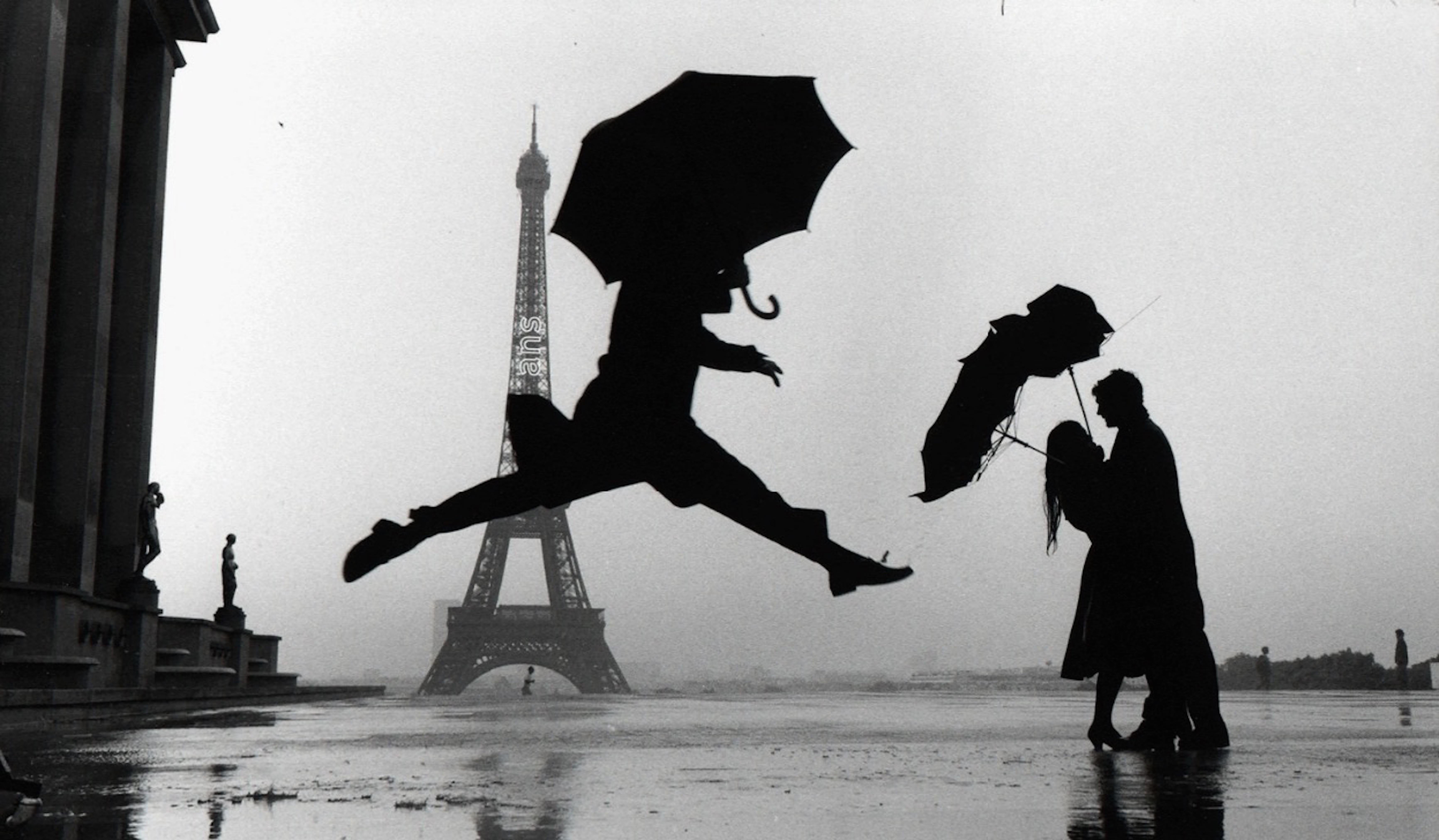
Elliott Erwitt
“Some people feel the rain, others just get wet"
~Bob Marley~
The umbrella is one of the most iconic motifs in photography. Whether photographed candidly or as an orchestrated set-up, umbrellas in art symbolize cultural significance, elegance and protection. The classic umbrella shape is undoubtedly photogenic. It can soften hard lines and become a graphic focal point, or act as a bullseye, directing the viewer’s gaze towards the subject. Regardless of weather, adding an umbrella to a photograph in an artistic way can create an air of mystery, intrigue and energy.
Rain, snow, fog and mist are meteorological phenomena that photographers love, as they create the perfect atmosphere for a dramatic and ethereal photograph. The semi-circular shape of an umbrella is an appealing addition to a variety of storylines.
“Oh Boy” by Pristine Clothes
“Getting Wet 2384” by Karen Celella
“The Road Less Traveled” by Alain Villeneuve
“Darkened Days to Come” by Jay Satriani
“Umbrella” by Kendisan Seruyan
“Right rute” by Milan Malovrh
"Messenger” by Ivan Marlianto
“STOP” by Anette Ohlendorf
The umbrella originated in China in the 1st century, where it was used as both an umbrella and a parasol. The umbrella as we know it today was invented by a Parisian merchant named Jean Marius in 1705. The word 'umbrella' comes from the Latin 'umbra', meaning 'shade' or 'shadow'.
“Crossing” by Ivan Marlianto
“crashing” by Hari Sulistiawan
“winter passengers” by Nicoleta Gabor
“Umbrellas…” by Thierry Dufour
“Mirror, mirror on the wall……………..” by Carlo Ferrara
“No.522” by Adirek M
“Colors of the Mediterranean” by Diana Junakovic
“rainy people out of a bus” by HAN dong hee
“Red Umbrella” by Weiwei
In the Bible, the umbrella is said to symbolize divine protection and grace and fellowship with God. Politically, it can symbolize resistance. It can also be used as a shield against pepper spray and tear gas.
In art, in both painting and in photography, the iconic shape of the umbrella is ubiquitous, often symbolizing togetherness, shelter, elegance, or simply bad weather.
“Enjoy the rain without getting wet” by Yvette Depaepe
“A Man from Kashmir (India)” by Joxe Inazio Kuesta Garmendia
“when everything must come to an end” by Djeff Act
'Umbrella” by Arman Kuzel
by Antonio Grambone
“Stormbringer” by Tetsuya Hashimoto
“Over There it is Raining” by Fernando Correia da Silva
I have not addressed umbrella handles but the wonderful photograph “Flamingo Close Up” by Xavier Ortega, when inverted, comes to mind.
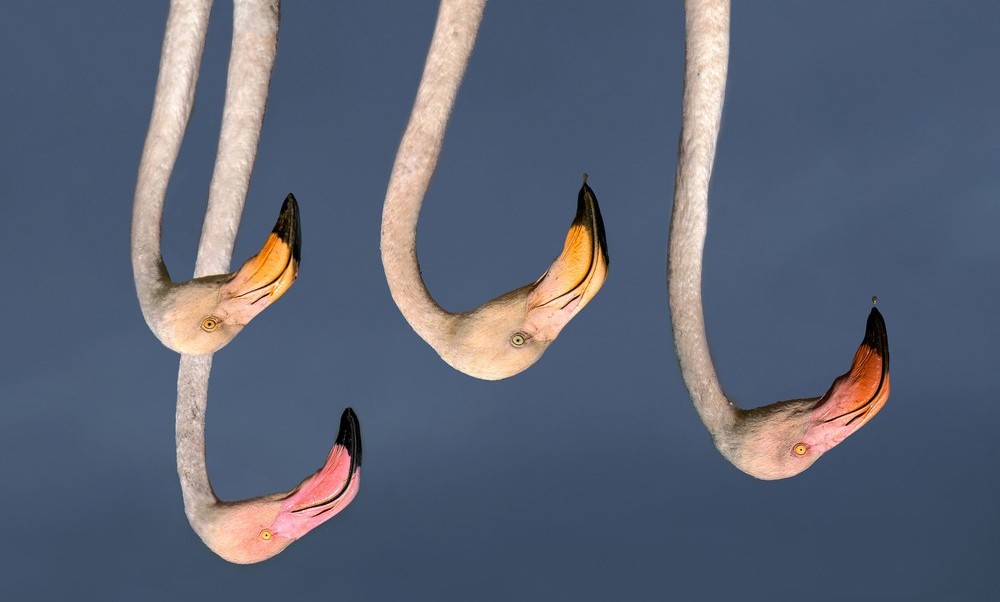 by Xavier Ortega (inverted with his permission).
by Xavier Ortega (inverted with his permission). |
 | Anette Ohlendorf PRO Thank you very much, a great compilation. |
 | Rae Zhang PRO Great collection of work! |
 | Roland Weber PRO A very nice story about an really overlooked item. Thanks for nice story and the brilliant photos.
My contratulation and again.. Chapeau!! |
 | Wanghan Li PRO Excellent works selected! Nice writing! Thanks a lot! |
 | Dazhi Cen PRO Creative and moody! |
 | Cicek Kiral CREW Great collection .... Congratulations... |
 | Biao Huang PRO Great ! |
 | Biao Huang PRO
;Great! |
 | Susan Beausang PRO A wonderfully written article with truly inspiring images. The photographs do an excellent job of highlighting the ideas behind using umbrellas as a compositional and storytelling element. Informative, creative, and a pleasure to read. |
 | Wonderful and inspiring collection of images. Lovely and elegant article, congratulations, Jane and Yvette! |
 | Izabella Végh PRO Un bellissimo articolo anche questo. Mi piace anche a me fotografare gli ombrelli. Qui a Venezia, dove le stradine sono così strette, certe volte difficilissimo camminare con gli ombrelli. Tanti anni fa, quando mi sono iscritta ad 1x.com, perché sulla rete ho trovato una fotografia, su questa e stata una scimmietta, sotto la pioggia, lei teneva sulla testa un foglio grande di palmo, come ombrello. Cerco ancora questa foto..... |
 | Lovely article and inspiring images!! Whimsy all wrapped up in history, iconography and wonder!! |
 | Thierry Dufour PRO Thank you Jane for selecting one of my images. Superb series. Congrats for your work !!! |
Tutorial led by Editor Michel Romaggi in collaboration with the author Tatsuya Moments
Edited and published by Yvette Depaepe, the 9th of December 2025
This photo was taken on a rainy evening in the city.
I was out walking with no particular destination in mind, simply enjoying the way the rain was softening the lights and reflections around me.
Then, when I noticed this woman standing quietly under her umbrella, illuminated by the blurred lights of passing cars and neon signs, I experienced a moment of stillness amidst the city's bustling rhythm.d this woman standing quietly under her umbrella, illuminated by blurred car lights and neon signs, I felt a moment of stillness in the middle of the city's rhythm.
‘Blue Silence’
My intention was not to document the person, but the atmosphere.
I wanted to capture the solitude and quiet strength, and the feeling of looking at the world through a thin veil of rain.
Equipment
• Camera: RICOH GR III
• Lens: Built-in 28mm equivalent
• Filters: None
• Tripod: Not used (handheld)
I started with a basic 'straight out of camera' file. It was during post-processing that the transformation occurred.
POST-PROCESSING (with Layer Breakdown)
My Editing Approach
The editing process is largely intuitive, driven by emotion rather than strict rules.
As I edit, I ask the image what it needs:
Softer highlights, deeper blues or more ambiguous textures, for example.
The final work becomes more than just a photograph of the moment;
but an interpretation of how that moment felt: silent, melancholic and dreamlike. The structure of the layers used in Photoshop is shown below, from bottom to top, and represents the actual workflow.
Post-Processing Workflow (with Visual Step-by-Step Screenshots)
Below is an overview of my editing process from step ① to ⑥, illustrated with actual screenshots from Photoshop.
These images show how each layer and effect transformed the photo as I built the final mood intuitively.
① Original Image — Base Composition
No major adjustments yet. Base composition only.

② Basic Color Setup — Photoshop + Color Look Up
At this stage, I applied a Color Look Up table to define the overall direction of the tones.
This creates the foundation of the cold, rainy atmosphere.
Brightness, contrast, and color balance were also lightly adjusted.

③ Nik 7 Color Efex — Establishing the Blue Mood
Using Nik Color Efex, I shaped the essential mood:
• softened highlights
• deepened the blues
• adjusted luminance and contrast
• clarified midtones
This step builds the emotional color base of the final image.
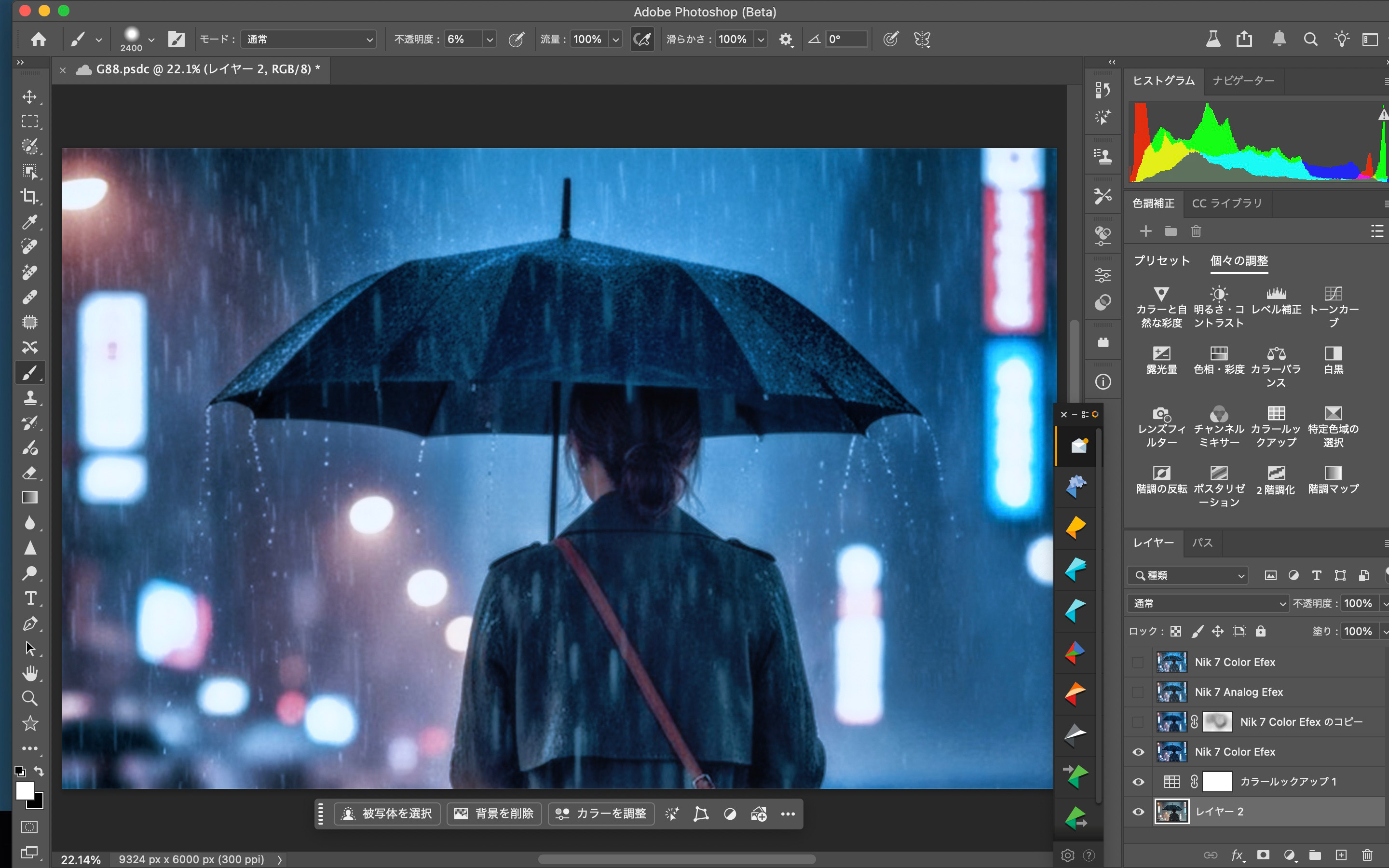
④ Duplicate Color Efex Layer — Motion Blur (~370)
I duplicated the previous Color Efex layer and added Motion Blur (approximately 370).
This enhances:
• the softness of background lights
• the smooth trails of rain
• the dreamy separation between subject and environment
A mask was used to control where the blur appears.
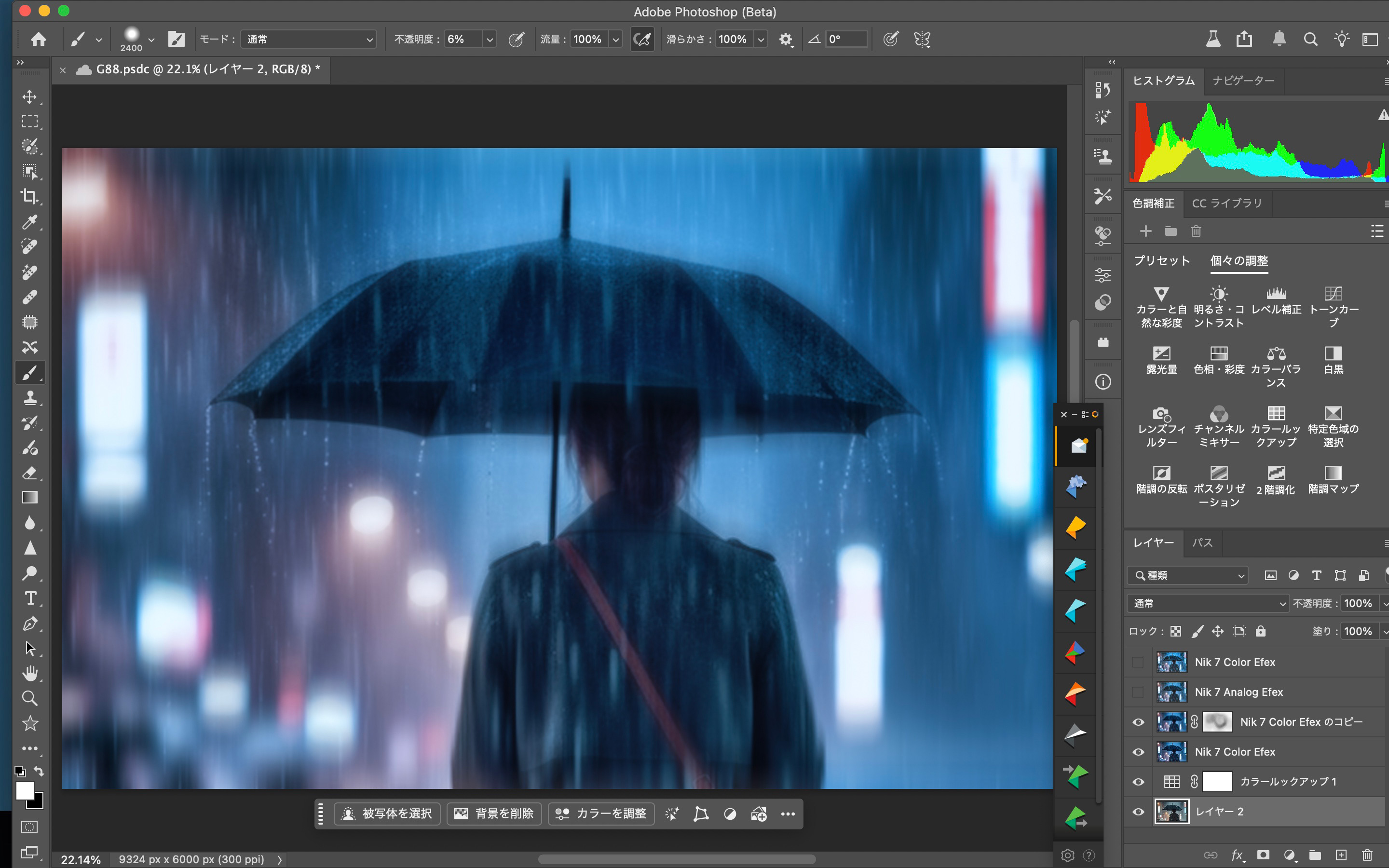
⑤ Nik 7 Analog Efex — Adding Textures & Imperfections
With Analog Efex, I added subtle layers of:
• scratches
• stains
• atmospheric haze
• film-like imperfections
These textures make the image feel like a memory seen through a wet, imperfect surface.
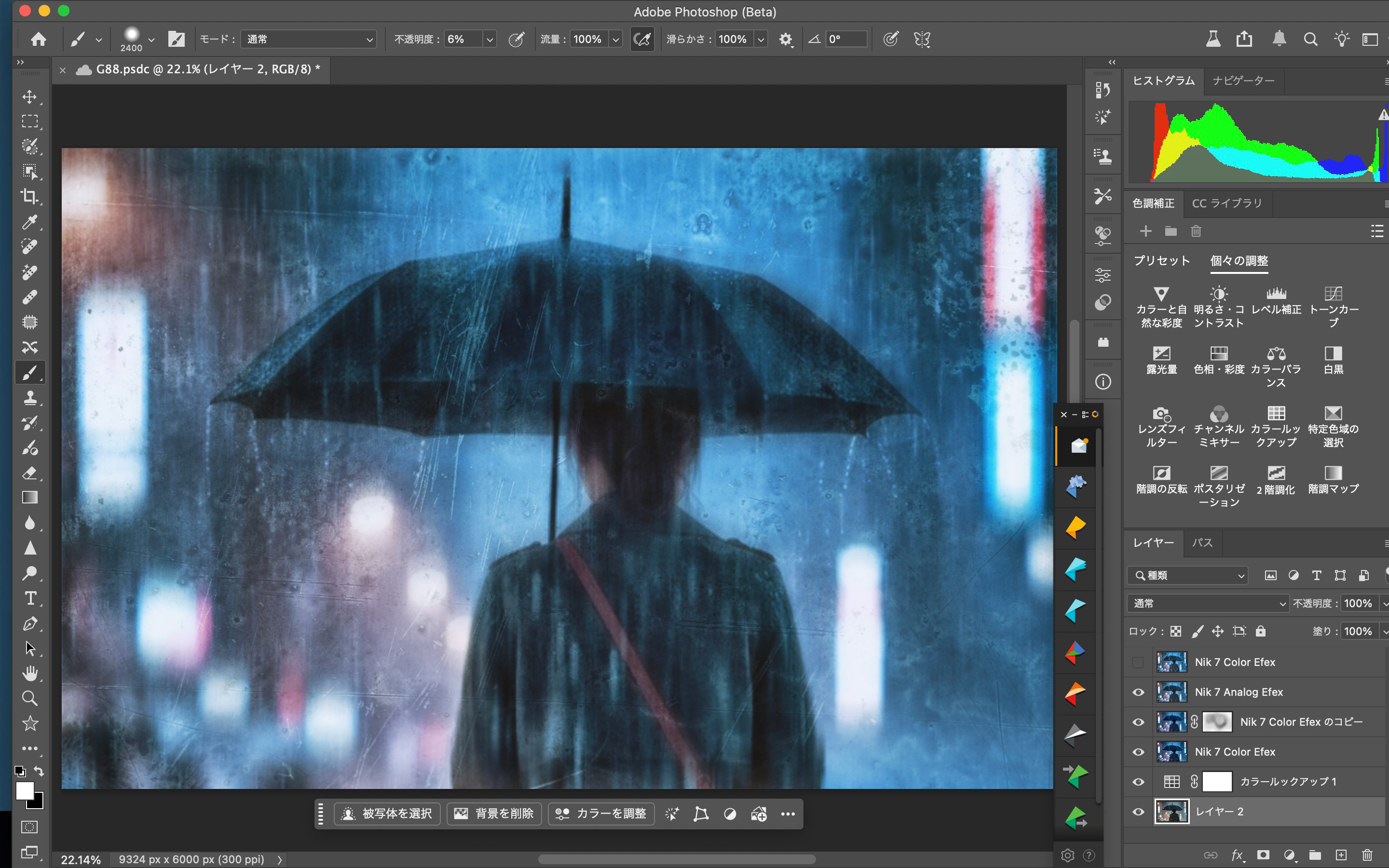
⑥ Final Adjustments — Nik Color Efex (Second Pass)
For the final polish, I returned again to Nik Color Efex, refining:
• saturation
• final blue tones
• contrast
• depth in shadows
This step brings cohesion and emotional depth to the whole image.
BIOGRAPHY
My name is Tatsuya, and I am a street and fine-art photographer based in Japan.
Photography began as a simple way to record daily life, but over time it became a language for expressing emotions that are difficult to put into words.
I am often drawn to themes such as rain, silence, and solitary figures—moments that hold a quiet story within them.
For me, a photograph is a small visual poem.
 |
 | joanaduenas PRO Impressive work, thanks for sharing your workflow. |
 | Chilsong Pak PRO Thank you for sharing. |
 | Thank you for sharing Tatsuya..for detail process in photoshop!! |
 | Leechee Z PRO Excellent !!!Thanks for sharing, Tatsuya. Thanks to 1X too. |
 | Thanks to Tatsuya, and to 1X.
|
 | Tracy Lee PRO Excellent work. Thanks for sharing the detail process. |
 | Cicek Kiral CREW Thanks a lot for your efforts. I like this a lot... |
 | Lynn Adams PRO Such a transformation, wow! Many kind thanks for sharing your insight and inspiration dear. A well deserved highlight! A lovely week ahead. |
 | Eiji Yamamoto PRO Thank you so much for sharing such an inspiring article! Congratulations! |
 | Miron Karlinsky PRO Thank you
|
 | UstinaGreen PRO Wonderful work with blue rein!
Fantastic light and tonality!
Many thanks for your presented! |
 | Excellent work, thanks for sharing! |
 | Excellent article! Thank you so much for sharing the image process in such detail. I think you successfully conveyed that immersive and mysterious atmosphere you envisioned from the beginning. Congratulations! |
by Yvette Depaepe
Published the 8th of December 2025
This months' featured exhibition is titled 'Crimson Realm: Abstract Images of Tailing Lakes' by Aidong Ning
I invite you to explore this amazing exhibition where photography is a poet of light, translating industrial scars into crimson verses as an admirer expressed so well in his review. Every image is breathtaking and incredibly powerful.
This exhibition which will be exposed on our opening page / Gallery throughout December 2025.
Click here to see the entire exhibition: [394] Crimson Realm: Abstract Images of Tailings Lakes by Aidong Ning
To trigger your curiousity, here is a short selection of images out of this exhibition.
 |
 | Steven T CREW Jane and Yvette, Thank you! I enjoyed the photos. Imaginative and delightful! |
 | Molly Fu APA PRO Absolutely stunning art pieces, details, color, mood and more....love them, the nature is so beautiful and lovely in your camera and your sharp photographer eyes, congrats mdf Aidong!!! |
 | Dazhi Cen PRO Amazing! |
 | Piet Haaksma PRO I am deeply impressed by your beautiful images. Congrats |
 | John Fan CREW Stunning work! Contratulations! |
 | Eiji Yamamoto PRO A very beautiful and interesting exhibition! Congratulations, dear Aidong! Thank you so much as always, dear Yvette! It's fun and interesting to learn about a world I don't know about! |
 | Shenshen Dou PRO This series of works is visually stunning! The rich interplay of form and color creates a powerful symphony! Congratulations dear Aidong! Thanks Yvette for introduce such wonderful work to us! |
 | Wayne Pearson PRO Brilliant natural landscape abstracts, congratulations Aidong. |
 | Nancy Sun PRO Amazing! Great work! Congratulations, dear Aidong! |
 | Linda Lu PRO What an extraordinary collection of images! Love the colors and how you present what you have seen. Congratulations! |
 | Yanyan Gong PRO Remarkable! Congratulations, dear Aidong! |
 | Irene Wu PRO Dear Aidong, Your work is truly stunning! Through the aerial perspective, you reveal such power, order, and beauty in the world.
Congratulations on being featured in 1X Magazine — I have much to learn from you! |
 | Nancy Lee PRO Your work has this quiet magic to it—I find myself admiring it from afar. Congratulation Aidong! |
 | Emel Sefer PRO Congratulations |
 | Wei Yu PRO Amazing shape and colors. Great work! Congrats my dear friend. |
 | Fan Lin (APA) PRO I can feel the power from the abstracted shape and color! Great job! Congrats my dear friend! |
 | Larry Deng APA PRO The most powerful images really do feel like a quiet conversation. They kind of ask you:
"What's catching your eye?" (The obvious stuff)
"What does it stir up in you?" (The gut feeling)
"Where does your mind go from here?" (The deeper thoughts)
You just nailed all three levels. That's the real magic of getting lost in art ,it gets your own thoughts talking to each other.
Thanks for sharing that. Honestly, it's really cool to hear someone put that feeling into words so well. Hope you keep finding art that meets your gaze and makes you see things a little differently.
Congrats df Aidong ++ |
 | Yvette Depaepe CREW Dear Aidong, each of those extraordinary images are telling us a story so well translated by you. I love your closing words and can feel your emotions. I will never see so much beauty from above and are so grateful that you are sharing it. Thank you so much! |
 | Larry Deng APA PRO Thank you dear Yvette for sharing these beautiful works. |
 | Yaping Zhang PRO 震撼人心的杰出抽象艺术创意作品,令人回味无穷!欣赏学习了 |
 | Kathy(Jie Xiao) PRO Amazing! |
 | Ruiqing P. PRO These images make me feel not just visually striking, but quietly profound, inviting us to look deeper and reflect on what looks back at us. Inspiring! |
 | lusiyuan-bubusy PRO wow |
 | Aidong Ning PRO Thank you 😊 |
 | Xuedong Bai PRO 巨作太奆了! |
 | Aidong Ning PRO 谢谢😊 |
 | There is so much beauty in the world, even in things that poison the earth, like these tailings whose shape and colours are defined by their interaction with the natural landscape. They form extraordinary abstract scenes, an eerie poetic atmosphere, surreal forms. The colours are amazing. I have never seen such views. Great work! |
 | Aidong Ning PRO Thank you so much for your beautiful comment, Ludmila! Nature is the greatest artist, I am always amazed by the artistic creations, especially in the unexpected area. |
by Editor Marius Cinteză
Edited and published by Yvette Deaepe, the 5th of December 2025
Claudiu Guraliuc is a full-time portrait photographer and educator hailing from Cluj, Romania, whose work transcends traditional boundaries, blending technical mastery with high art. A Master Photographer, Claudiu holds esteemed distinctions, including Associate of The Master Photographers Association (UK) and Professional Associate of the Royal Photographic Society of Great Britain. His portfolio over the last five years, encompassing more than 100 international couples and diverse commercial clients, from IT firms to luxury retailers.
His commitment to excellence has earned him top global recognition. In 2020, he was named Fine Art Photographer of the Year at the Master Photography Awards Gala (UK) for his baroque-inspired work, followed by the coveted International Master Photographer of the Year 2021 award.
In a historic achievement for Romanian photography, Claudiu won the European Bronze Camera in Fine Art from the Federation of European Professional Photographers (FEP) in 2023.
Most recently, in June 2024, he secured the prestigious Laudamus Prize for Sacred Art in the UK, prevailing over 1,200 artists globally. His acclaimed artwork is featured in galleries and private collections across Europe, Asia, and the United States.
Join me as we step behind the scenes to uncover more about Claudiu's unique vision and journey in this exclusive full interview!
The Last Chew
Beyond your renown in photography, what personal interests or unique hobbies offer balance to your artistic focus?
When I’m not in the studio, you’ll most likely find me in the kitchen or on the couch. I love to cook—slow dishes, sauces that take patience, stuff like that. And I binge-watch TV shows, especially sci-fi. World-building relaxes me and perhaps secretly fuels my work; a good series is a lesson in lighting, composition, and myth.
Pentheus and the Maenads
Looking back, what was the defining moment when you realized photography was your personal connection to the world?
How deeply does this medium define you?
Discovering pictorialism was the spark. It told me that photography could carry the weight, ambiguity, and tenderness of painting—that it could be interpretive, not merely descriptive. Since then, life has narrowed beautifully to two axes: family and photography. They’re not separate; my family gives purpose to the work, and the work gives structure to our life.
Adoration
Your style is fine-art portraiture. What draws you so strongly to a conceptual, human-centred approach?
People are inexhaustible. A face is geography, history, theatre, and prayer—often in the same minute. Conceptual portraiture lets me stage that inner weather. I can borrow symbols from myth and painting, then invite a living, breathing person to animate them. When the concept and the human line up, a portrait becomes a mirror for the viewer too.
Allegory of War
What elements or sources of inspiration keep you creating new works?
I believe our images say more about us than about our subjects. They’re sediments of our experiences, memories, books, music, dreams—and yes, our traumas and biases. I read widely, listen to music obsessively, and keep notes on colour moods and story fragments. Everything eventually distils into a picture. I also think the brain is a very simple tool—brilliant, but simple. It tends to produce echoes of whatever you feed it. If you live on a diet of trends and short clips, it will remix trends and short clips. If you nourish it with painting, poetry, theology, science fiction, Baroque aesthetic, silence, and real conversation, it will return work with deeper fibres. So I curate my inputs like I colour-manage my workflow: museum days, rereading the Old Masters, long playlists, good novels, and intentional “fasts” from the algorithm. Cross-pollination matters; I’d rather steal a chord progression from Monteverdi or a sentence rhythm from Márquez than another lighting setup from Instagram. What you feed grows—and I want my work to grow from timeless sources.
Adam and Eve
In your niche, what’s the most persistent creative or logistical challenge?
Casting and logistics. Finding the right collaborators—models who embody a concept, stylists who understand restraint, access to wardrobe/props with timeless patina—takes time. Practically, there’s budget math, shipping large prints safely, and defending long pre-production windows in a world that wants things “by Friday”. And then there’s space: staging ambitious sets requires square meters I don’t always have—studio rent in my city makes “room to think” a very real, very monthly challenge. Creatively, the hardest discipline is staying brave enough to make work for myself first, markets second. The moment you start creating what you think others will like, you step onto a treadmill of futility—forever chasing an ever-shifting taste. I’d rather miss a trend than miss my voice.
Adoration II
What turns a good portrait into an exceptional one?
The most truthful moments live between gestures—when you feel safe enough to be present without a mask. That’s why great portraits aren’t about perfect smiles; they’re about honesty and permission to appear exactly as you are. Add to that: a clear intention, a hierarchy in composition, light that shapes meaning (not just exposure), color harmony that supports the emotion, eloquent hands, and edges that guide attention. And patience. Lots of patience and perseverance.
Birth of Venus
How do you communicate your vision to models—scripts, dialogue, or something else?
I start with a model call tailored to the concept. Once cast, we build a shared language: a moodboard, references, a brief “script” of emotional beats, and a group chat for practicalities. We meet or at least talk through things like wardrobe, gesture, and pacing.
On set I direct through verbs and feelings rather than rigid poses, leaving space for the subject’s own authorship.
Bubblegum Flamingo
How do you balance rigorous preparation with on-set instinct?
Planning is my superpower. I map everything I possibly can: props, blocking, lighting diagrams, and value structure in advance. But I operate a 90/10 rule: 90% is premeditated so that 10% can be discovery. I always leave one variable open—a hand, an expression, a drape, a shaft of light. That’s where life slips in.
Dualities
Beyond technique, what artistic principles or colour choices create the mystical, ethereal quality in your images?
I often favour analogous colour harmonies, much like many Renaissance artists used to describe form and space. I keep the hue of shadows closely related to the lit areas to create believable transitions and a three-dimensional presence, preserving local colour while modelling with tonal range. Value design comes first; chroma is then tempered like glazes. Saturation is earned, not assumed.
Like Father like Son
Where does a story begin for you—emotion, prop, or myth?
With a closed-eye picture. I need to be able to “project” the final image on the inside of my eyelids: light direction, colour, composition, the weight of fabric, where the hands rest, the expressions of the models. Once I can see it, the rest is translation—taking the story from mind to studio.
Antonomasia
How important is it that viewers read your intended narrative versus completing it themselves?
Photography is communication, and every message passes through both the sender’s and the receiver’s filters. I try to craft a clear intention and a scaffold of symbols, but I want the viewer to bring their history to it. Ambiguity isn’t a mistake; it’s an invitation.
Bubblegum Bacchus
The gear debate is endless. What’s your go-to setup right now?
For studio work I rely on the Fuji GFX100S paired with the GF 110mm f/2. The medium-format files give me generous tonality and a graceful falloff around the subject—perfect for painterly work. I tether, light with large sources feathered across the form, and shape with flags and negative fill. Lenses are tools; the 110/2, in particular, is my favourite for rendering faces and bodies.
Portrait of a Lady and Her Ancestor
You won the FEP European Bronze Camera (2023) and the Laudamus Prize for Sacred Art (2024).
How did these shape your vision and development?
They were milestones of encouragement and responsibility. Recognition opened doors to institutions and collaborators I admire, but more importantly it challenged me to refine my voice—to pursue deeper research, better craft, and bolder narratives. Awards fade; the obligation to grow remains. The only real competition is with yourself and the struggle of being a little bit better than yesterday.
Invisible Tempest
Describe a recent favourite photograph and the story behind it.
Pietà is dear to me. I wanted to re-engage a sacred archetype through contemporary portraiture—grief as a universal, not historical, condition. We built it with real drapery, restrained palette, and meticulous hands placement. The light is feathered from above-left, with negative fill to keep the values solemn. There’s a quiet halo suggested by separation, not a graphic line. On set, we let silence do the directing. What moved me most was the tenderness between the models when the camera wasn’t clicking—that “between gestures” truth.
Pieta
Which photographers, artists, or mentors have most influenced your eye?
I began as a wedding photographer, and Jerry Ghionis was my first true mentor—his approach to light, posing, and storytelling taught me discipline and empathy. Beyond photography, the Old Masters—Caravaggio, Rembrandt, Velázquez, Vermeer—are my compass for value, colour, and narrative restraint. Among photographers, the pictorialists (Cameron, Stieglitz, Steichen), and modern voices like Paolo Roversi continue to teach me sensitivity.
Judith with the Head of Holofernes
What exciting projects or new directions are next for you?
Introspecții (Introspections) is my current long-form project. It’s a studio portrait series where each sitter holds a mirror. In that mirror, they choose—without my intervention—what to reveal: something intimate, usually kept hidden. The primary portrait shows the face we offer the world; the mirror discloses a private truth. Participants are volunteers, co-authors of their image. The project will live as an exhibition, a book, and a set of limited prints, maybe with an educational program built around it. It’s about courage, permission, and the double exposure of being human in our day and age.
Cupid Chastised
Ecstatic Dance of Duality I
Ecstatic Dance of Duality II
Gamblers
 |
 | Yaping Zhang PRO 精美绝伦的杰出艺术作品!令人赞不绝口!恭喜克劳迪乌艺术大师 |
 | Amazing work, talent, imagination, attention to detail! Great interview! |
 | Elian Coman PRO Excellent interview! Such abundant, rich content and truly inspiring ideas - beautiful thoughts shared throughout. Claudiu is the artist and teacher who has influenced me the most in my creative journey so far and he remains the photographer and portraits creator that I admire above all others. |
 | Marius Cinteza CREW Thank you so much, Elian, for the kind words!! |
 | brilliant |
 | Iris Wiener PRO Excellent work. what an imagination!!! |
 | Svetlana Kirzh PRO Fantastic work. Amazing imagination, congrats Claudiu |
 | Kevin Christonar PRO really magnificent work! |
 | Dragoslav Nedici PRO Amaizing work!!! Congratulations!!! |
 | quel travail magnifique
|
 | Grigore Roibu PRO Felicitări pentru tot ceea ce faci! |
 | Thierry Dufour PRO Fantastic work, congrats Claudiu, thank so much Marius !!! |
 | Marius Cinteza CREW Thank you, Thierry! Have a great day! :-) |
 | Rae Zhang PRO Amazing imagination and work! |
 | Vitée Tao PRO Amazingly inspiring work, Claudiu. |
 | Ovi D. Pop PRO Rock!! |
 | Eiji Yamamoto PRO Dear Claudiu, thank you so much for this wonderful interview with great photographic artworks! Dear Marius and dear Yvette, thank you so much! It's very inspiring! |
 | Marius Cinteza CREW Many thanks, Eiji! Have a great week ahead! :-) |
 | Miro Susta CREW Wonderful photo work, highest liga of portrait photography, congratulations on your success and excellent work Claudiu, many thanks.Marius and Yvette for bringing it to us |
 | Marius Cinteza CREW Thank you, Miro! The pleasure is mine! :-) |
 | Emel Sefer PRO Outstanding work, congratulations |
 | Gila Koller PRO Outstanding work Claudiu!! |
 | Martine Benezech PRO magnifique et inspirant travail. Bravo |
 | Congratulation Claudiu, always admire your work, my favorite one its Pi |
 | DDiArte PRO Great!!!!! Love it!!! Impressive!!! |
 | Laura Cornea PRO outstanding work |
 |
An enviable job |
 | Claudiu Guraliuc PRO Big thanks to Marius for the invitation, and to everyone who took a moment to leave a kind word. It means a lot—thank you for the support. |
 | Marius Cinteza CREW Claudiu, thank you so much for the excellent collaboration! It was a pleasure to work with you! I'm thrilled that your amazing portfolio and compelling story are now accessible to all 1x readers! :-) |
 | Miron Karlinsky PRO I really liked it. Thank you ! |
 | masterpieces, chapeau claudiu !!! ☝️ |
 | Elena Raceala CREW Congratulations, Claudiu, on your sophisticated and stunning conceptual portraiture and the excellent combination of complex scenes and ethereal atmosphere. Wonderful, Marius, for bringing Claudiu's impressive work here! Great interview! |
 | Marius Cinteza CREW Many thanks, Elena, for the kind words! :-) |
 | Felicitari Claudiu. Te urmaresc de ceva vreme. Munca ta, fotografiile realizate de tine sunt dintr-o alta lume. Apreciez mult tot ce faci, inspiri si pe altii prin aceste imagini absolut minunate. Ma inclin. |
 | Gabriela Pantu PRO Brilliant collection of pictures, mastering the light and the visual storytelling and expression for very complex scenes with many characters, truly an inspiration.And also great interview.Congratulations, dear Claudiu, for the amazing artist you are.Congratulations and thank you dear Marius and dear Yvette, as always. <3 |
 | Marius Cinteza CREW Thank you, Gabi, for the kind words! :-) |
 | Izak Katz PRO Very creative images !! .
|
 | Ilan Amihai PRO wow master peace |